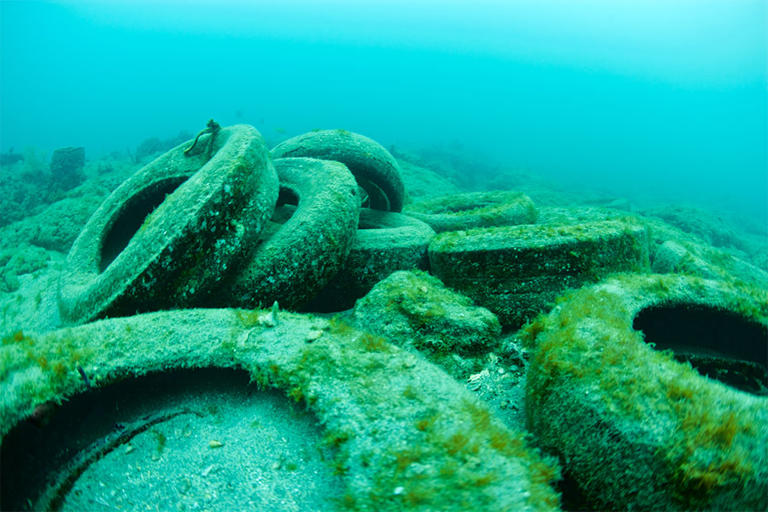At first glance, this looks like an army of tires resting at the bottom of the sea. That’s because that’s exactly what they are.
It’s over two decades down the line and passionate environmentalists still regret their decision to bury two million discarded tires in the sea. What was initially intended to be an environmentally life-saving adventure featuring lots of rubber and good intentions has backfired pretty badly.
Now the Osborne Reef Project has cemented its reputation as a monumental disaster. Efforts have now been set in motion to rid the sea bed of these unwelcome visitors. But how did it all start?
It was in the good old 1970s when a local nonprofit decided on a plan to imitate the benefits of coral reefs to the environment. These benefits include the protection of the coastlines from erosion and storms, boosting the capacity of the reef to supply food and new medicines, plus increasing recreational value. But this time, lots of rubber tires were at the center of the plan.
This nonprofit was able to court the support of the U.S. Army Corps of Engineers while a navy minesweeper USS Trush oversaw the operation. A collaboration with a tire manufacturer was essential to getting such a humongous number of discarded tires. Goodyear Tire and Rubber Company, a veteran tire manufacturer filled this vacuum.
It is important to know that the success of the experiment greatly leaned on the connection between the tires. The tires had to stay together to get the job done.
To achieve this bond, the nonprofit used steel clips and nylon ropes. It didn’t take long for the bindings to unravel. The steel clips began to wear off due to corrosion, destroying the arrangement and the wildlife that had begun to find a home in the new reef.
Besides destroying the progress already made, the failure of the project was heightened by the attendant inability of new wildlife to grow. In addition, heavy coastal winds cause the tires to clash against one another, sending several of them beyond the boundary of the reef. This led to the littering of the beaches and the ruin of the reef.
Interestingly, the Osborne Reef project isn’t the first of its kind. There have been similar endeavors across the globe. There have been artificial reefs built in Malaysia and Indonesia with tires. These also have matured into monumental disasters. Hurricanes have helped contribute to these failures by scattering thousands of tires to unwanted sections of the sea.
These failed reef projects have produced more headaches for environmentalists who are desperate for help in cleaning up the mess. Thankfully, several organizations have come to the rescue.
Quite an encouraging number of concerned organizations and individuals have lent a helping hand in remedying the failed reef projects. The Osborne Reef got the attention of Dr. Robin Sherman, a professor of Oceanography and Associate Dean at Nova Southeastern University’s Hamos College of Natural Sciences and Oceanography.
In 2001, she successfully qualified for a grant from the National Oceanic and Atmospheric Administration (NOAA) worth $30,000. This grant was to facilitate the cleanup of the artificial reef.
Dr. Robin, who had spent several years researching artificial reef function could better appreciate the damage of the Osborne Reef project to aquatic wildlife than most environmentalists. She was able to remove over 1,600 tires from the reef. This cleanup tagged the Osborne Tire Reef Cleanup, attracted lots of appreciation including the 2008 Coastal America Partnership Award for her environmental remediation efforts.
Other cleanup efforts include those from Florida’s Broward County who in 2002, collaborated with companies whose activities had been detrimental to the reefs. These companies were to join hands in cleaning up the Osborne Reef as part of efforts to compensate for their destructive construction activities. Over $40 million was earmarked for this initiative.
The story of the Osborne Reef cleanup efforts can’t be complete without the mention of the contribution of the U.S. military. Again, Florida’s second most populous county, Broward County led the efforts.
County officials convinced the military to fit the Osborne Reef cleanup into their Innovative Readiness Training Program. This program provides the military with an opportunity to simultaneously contribute to civilian well-being and military readiness. The cleanup exercise also served as a training opportunity for military personnel.
The military intervention which kicked off in 2007 was an ongoing project planned to last for several years. Tagged DiveExEast07,” the initiative has continued to reduce the number of unwanted tires in the Osborne Reef. By the end of 2009 when the military terminated their intervention to focus on other operations, over 73,000 tires had been reportedly recovered from the reef.
A more recent cleanup effort however was executed by the Industrial Divers Association (IDC) from 2016 to 2019. The association successfully pulled out over 250,000 tires within this period.
In 2021, 4Ocean, a recycled bracelet retailer, announced their plan to rid the Osborne Reef of the remaining tires. 4Ocean plans to sell bracelets made off the recovered tires to fund the cleanup process. Hopefully, the company will rid the reef of the estimated 500,000 still resting at the bottom of the sea.



















